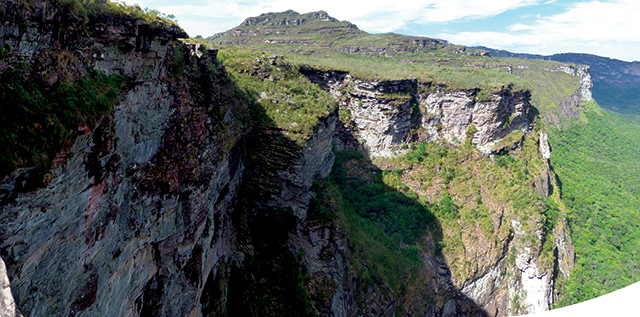
by Adityarup "Rup" Chakravorty Wednesday, June 15, 2016

In outcrops of the Tombador Formation in the Bahia state of Brazil, researchers found evidence of ancient channel-braided rivers — which combined traits of modern sheet-braided and meandering rivers — that existed before plants colonized land. Credit: Bruno Boito Turra.
It might be difficult to imagine Earth devoid of vegetation, but for billions of years the sun shone, winds blew and rivers flowed on a planet without any plants.
Until recently, researchers believed that without plant roots to stabilize stream banks, most pre-vegetation rivers would have been wide and shallow, with unstable banks and large bed-loads — coarse sediments that roll, slide or are dragged along the river bottom. These so-called sheet-braided rivers had multiple channels, their waters flowing around braid bars formed by deposition of all that coarse sediment.
But a new study, published in Geology and led by Renato Paes de Almeida, a fluvial geologist at the University of São Paulo in Brazil, adds to recent research indicating that ancient rivers may have been more complex and diverse than previously thought.
“Most models consider that pre-vegetation rivers were very similar to rivers in high-slope areas today: sheet-braided with relatively high sediment loads,” Almeida says. “We wondered if that was the case with ancient rivers flowing through relatively flat areas as well.”
Today, in such low-slope areas — floodplains, for example — most rivers are sinuous, with a single channel meandering back and forth. Meandering rivers are usually deeper than sheet-braided rivers, and unlike the coarse, heavy bed-load carried by sheet-braided rivers, most of the sediment carried by meandering rivers is finer-grained and suspended.
“Meandering rivers owe a lot to vegetation along their banks,” Almeida says. “We created a model to try to understand what rivers in a pre-vegetation world would look like in the same topographies that have meandering rivers today.”
The model predicted that pre-vegetation rivers flowing through low-slope areas would have had characteristics of both meandering and sheet-braided rivers. Without land plants and their complex root systems to stabilize banks and reduce erosion, these hybrid channel-braided rivers would have been shallower than typical meandering rivers. But, compared to sheet-braided rivers, they would have had deeper channels — up to several meters deep — as well as larger braid bars and bed-loads consisting of finer particles.
Martin Gibling, a researcher at Dalhousie University in Halifax, Nova Scotia, who was not part of the study, says studies like this one are making it “clear that the sheet-braided model is only a partial representation of pre-vegetation rivers.”
A significant challenge in studying pre-vegetation rivers is that it is very difficult to find a real example of one today with which to check models. “There is virtually nowhere on the modern Earth where you could go to find an analogue,” Gibling says.
So, Almeida and his colleagues compared their numerical modeling with field observations from the Tombador Formation in the Bahia state of Brazil, which includes extensive exposures of Precambrian fluvial deposits laid down prior to plants first colonizing land in the Ordovician.
In outcrops of sedimentary rock in the Tombador Formation, they saw evidence of a river system that transitioned from a braided channel that was only a couple of meters deep at steep slopes to one with deeper channels — up to 5 meters deep — and larger braid bars downstream, where the terrain was flatter.
These field observations matched their modeling results and, according to Almeida, provide important evidence that in relatively flat areas, pre-vegetation rivers varied significantly from the generally accepted sheet-braided model.
This terrain-dependent difference in pre-vegetation rivers might be more prevalent than previously thought. “A lot of the pre-vegetation [rock] strata that have been studied may have been formed quite close to mountain fronts, and we may know less about what happened [to rivers] far out on the plains than we supposed,” Gibling says.
Gibling notes that the field observations in the new paper are useful, but says that they “give only a very brief account of the Tombador Formation. It will be interesting to see more of the architecture.”
Beyond understanding the basic shapes of ancient river systems, detailing how pre-vegetation rivers flowed may be important for understanding nutrient delivery to Precambrian and early Phanerozoic oceans. Almost all sediment reaching the oceans today is delivered by big, meandering rivers. These sediments bring minerals to the ocean and are crucial for marine life, and this was likely also true before plants colonized land.
How efficiently sediments are transported by rivers depends on factors including channel depth and flow rates. “Most sediments get stuck if you have very mobile, shallow channels — such as in sheet-braided rivers — and they don’t reach the sea,” Almeida says. “The entire sedimentary flux of the ocean would have been different in the past with shallow rivers.”
© 2008-2021. All rights reserved. Any copying, redistribution or retransmission of any of the contents of this service without the expressed written permission of the American Geosciences Institute is expressly prohibited. Click here for all copyright requests.